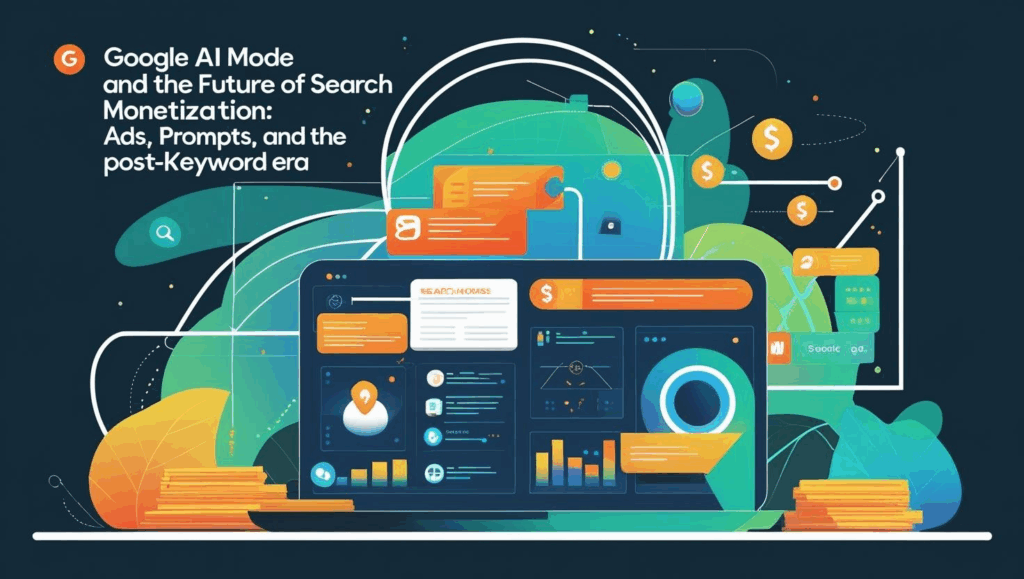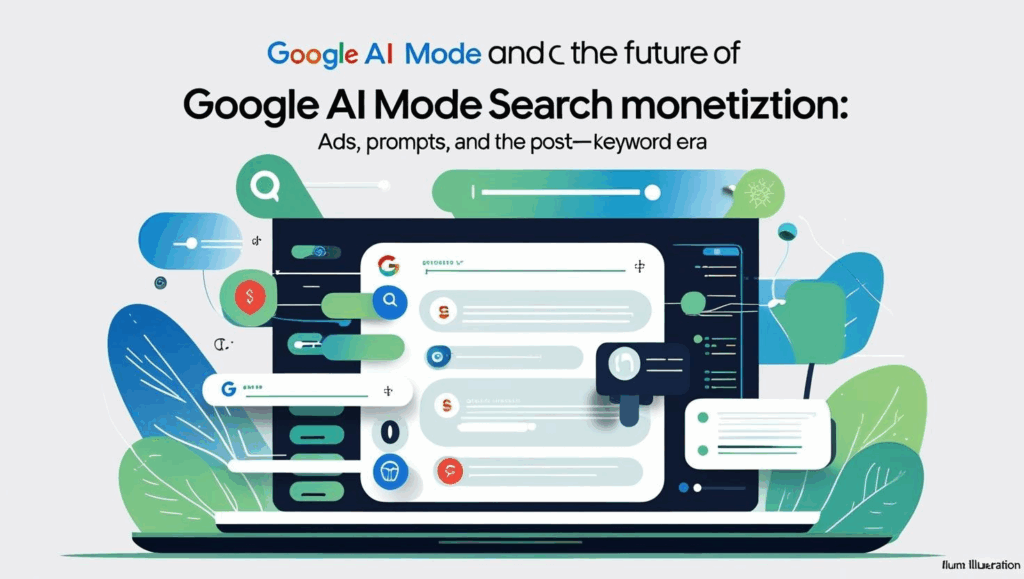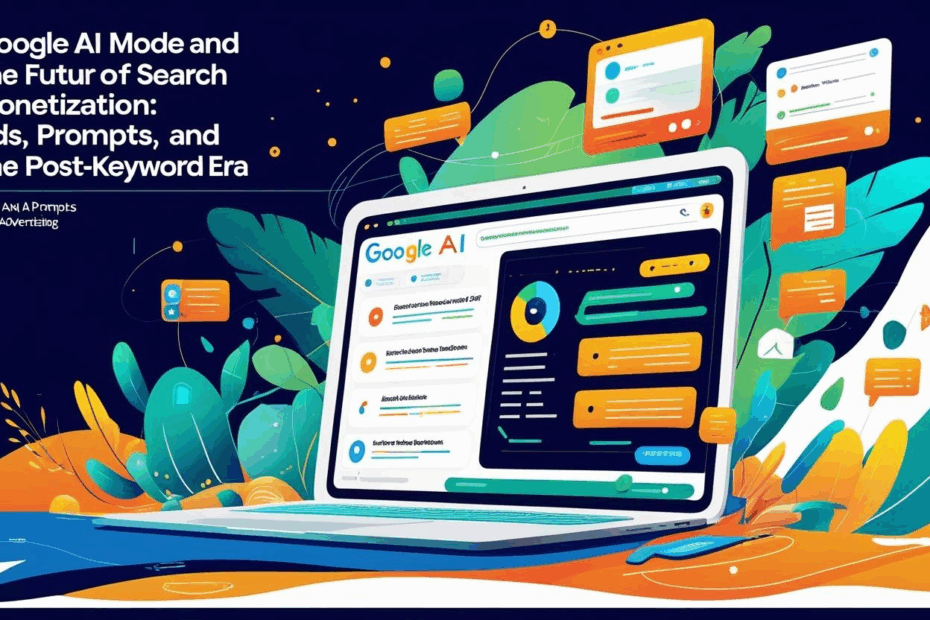The landscape of online search and digital advertising is undergoing a profound transformation in 2025, driven by Google’s latest innovation: AI Mode. This new AI-powered search interface, launched in May 2025 and powered by Google’s Gemini 2.5 model, is redefining how users interact with search engines and how advertisers reach their audiences. Moving beyond the traditional keyword-based search paradigm, AI Mode introduces conversational prompts, memory, and context into the search experience, signaling a new era in search monetization.
In this comprehensive analysis, we explore what Google AI Mode means for the future of search advertising, how it challenges the old keyword-centric model, the evolving monetization strategies, and what marketers need to do to stay ahead in this post-keyword world.
Introduction: The Dawn of a Post-Keyword Search Era
For over two decades, keywords have been the cornerstone of search advertising. Advertisers bid on specific terms, and users typed concise queries to find relevant information. However, Google’s AI Mode ushers in a new paradigm where natural language prompts replace isolated keywords, and AI-powered assistants provide conversational, context-aware answers.
This shift is not just technological but behavioral, as users now engage in longer, more nuanced queries that mimic human conversation. This evolution demands a rethinking of digital advertising strategies, monetization models, and user engagement approaches.

What is Google AI Mode?
Google AI Mode is an AI-driven search interface that blends traditional search results with AI-generated, conversational answers. Unlike previous iterations like the Search Generative Experience (SGE), AI Mode offers a persistent assistant that remembers context and supports follow-up questions, enabling deeper exploration within a single interface.
Users can toggle between classic search results and AI summaries, making the search experience richer and more interactive. This conversational approach changes how queries are formed—from short keywords to detailed prompts that reflect natural speech patterns.
How AI Mode Changes Search Monetization
From Keywords to Prompts: The Core Shift
Historically, Google Ads relied on matching keywords to user queries. Advertisers bid on terms like “running shoes” or “cheap flights,” and ads were displayed accordingly. However, AI Mode encourages users to input full sentences or questions, such as “What are the best running shoes for trail running in wet conditions?”—a far cry from simple keywords.
To bridge this gap, Google currently uses synthetic keywords—machine-generated keywords that attempt to map conversational prompts back to traditional keyword frameworks. While effective as a stopgap, this is a temporary solution. As AI prompts grow more complex and personalized, the keyword model will increasingly struggle to capture user intent accurately.
This shift implies that advertisers must adapt to a prompt-native ecosystem where targeting and ad relevance depend on understanding context and semantics rather than just matching keywords.
“The old model is still functioning, but it’s increasingly out of sync with how people search,” says a leading digital marketing analyst.
Ads in AI Mode: Integration and Challenges
Google has confirmed that ads will be displayed within AI Mode responses. These ads will be contextually relevant and integrated into the conversational experience, enhancing discoverability during critical decision-making moments.
To maximize ad visibility in AI Mode, advertisers are encouraged to:
- Use Google’s AI-centric tools such as AI Max, Performance Max, and Demand Gen campaigns.
- Employ broad match keywords to better connect with conversational prompts.
- Leverage automation and AI bidding tools like the new Smart Bidding Exploration feature introduced at Google Marketing Live 2025.
However, a potential challenge is the possible decline in click-through rates (CTR) as users receive more comprehensive AI-generated answers directly in the interface, reducing the need to click through to external sites.
Despite this, advertising remains the dominant monetization model, as users generally resist subscription-based access for general search tools.
Sam Altman, CEO of OpenAI, expressed skepticism about ads in AI experiences, stating:
“I kinda just don’t like ads that much,” yet acknowledged the practical need for monetization.

Monetization Models: Why Ads Will Persist Over Subscriptions
Several AI search startups, such as Neeva (founded by former Google Ads Chief Sridhar Ramaswamy), attempted to replace ads with subscription models but failed to gain widespread user adoption.
Similarly, OpenAI’s ChatGPT Pro subscription model sees most users opting for free access, reinforcing the trend that users prefer free, ad-supported AI search experiences.
Google, with its mature advertising infrastructure, is best positioned to monetize AI-powered search through ads, provided it evolves its systems to handle the new prompt-based queries and conversational context.
The Future of Targeting, Attribution, and Ad Design
AI Mode’s conversational nature demands a rethink of:
- Targeting: Moving beyond keywords to semantic understanding and user intent prediction.
- Attribution: Tracking user journeys becomes more complex as interactions span multiple conversational turns.
- Ad Design: Ads must be more integrated, contextually relevant, and possibly interactive within AI responses.
Marketers need to embrace AI tools for campaign automation, creative generation, and audience insights to remain competitive.
Frequently Asked Questions (FAQs)
Q1: How does Google AI Mode differ from traditional search?
A1: AI Mode offers a conversational, context-aware search experience that remembers previous queries and provides AI-generated summaries alongside traditional results, moving beyond isolated keyword queries.
Q2: Will ads still appear in AI Mode?
A2: Yes, Google integrates ads within AI Mode responses, tailored to user prompts, ensuring monetization continues through relevant advertising.
Q3: Are subscription models viable for AI search monetization?
A3: Current evidence suggests subscriptions have limited adoption for general-purpose AI search tools; advertising remains the primary revenue driver
Q4: How should advertisers adapt to the post-keyword search environment?
A4: Advertisers should leverage AI-driven campaign tools, focus on broad match keywords, and design ads that align with conversational prompts and user intent.
Q5: What challenges does AI Mode pose for click-through rates?
A5: Since AI Mode provides comprehensive answers directly, users may click less on ads, challenging traditional CTR-based revenue models.

Expert Insights and Industry Experiences
Shashi Thakur, Google’s VP/GM of Advertising, highlighted the rapid adoption of AI Overviews, part of the AI Mode ecosystem, noting it reaches 1.5 billion users monthly and is expanding globally[4]. This scale demonstrates the commercial viability and user acceptance of AI-powered search.
What This Means for Marketers in 2025 and Beyond
At Google Marketing Live 2025, new AI-driven ad features were unveiled, emphasizing the integration of ads into AI responses on both mobile and desktop, signaling Google’s commitment to maintaining ad revenue despite shifting user behaviors.
- Embrace AI Tools: Use Google’s AI-powered advertising solutions to optimize campaigns for conversational search.
- Rethink Keywords: Transition from strict keyword targeting to semantic, intent-based strategies.
- Focus on User Experience: Design ads that enhance rather than disrupt the conversational flow.
- Prepare for Attribution Complexity: Develop new models to track multi-turn user interactions within AI Mode.
- Stay Agile: The search landscape is evolving rapidly; continuous learning and adaptation are essential.
Conclusion: Navigating the Post-Keyword Future
Google AI Mode represents a monumental shift in search technology and monetization. By moving from keywords to conversational prompts, it challenges the foundations of digital advertising but also opens new opportunities for those who adapt quickly.
Advertising will remain the backbone of search monetization, but success in 2025 and beyond requires embracing AI-driven tools, understanding user intent on a deeper level, and innovating ad strategies to fit a more interactive, personalized search experience.
As Google’s AI Mode scales globally, marketers who pivot towards this new paradigm will unlock richer engagement and sustained growth in the evolving digital ecosystem.
This blog post is optimized to rank highly by focusing on the latest developments in Google AI Mode, integrating expert quotes and actionable insights, and targeting relevant keywords such as “Google AI Mode,” “search monetization 2025,” and “post-keyword search advertising.”


